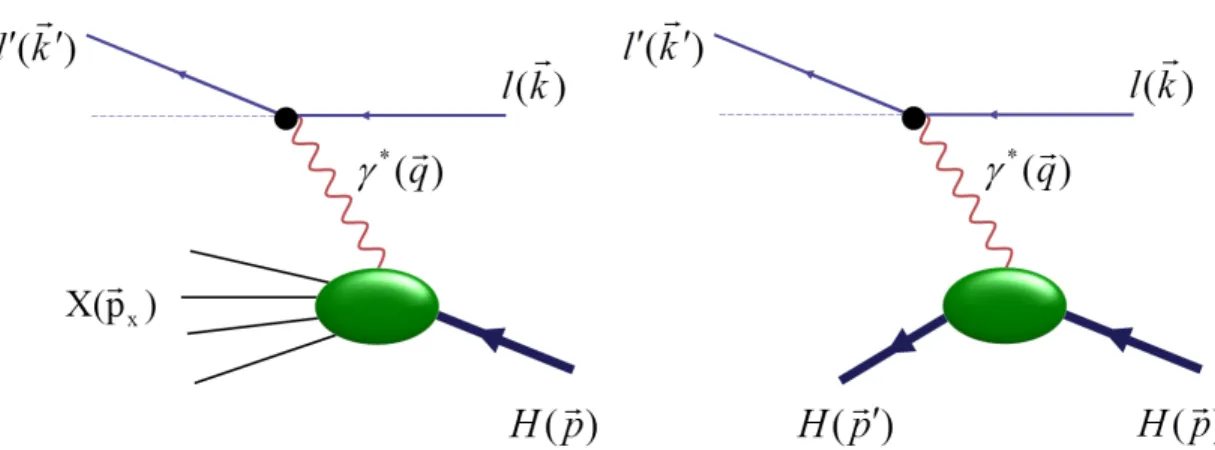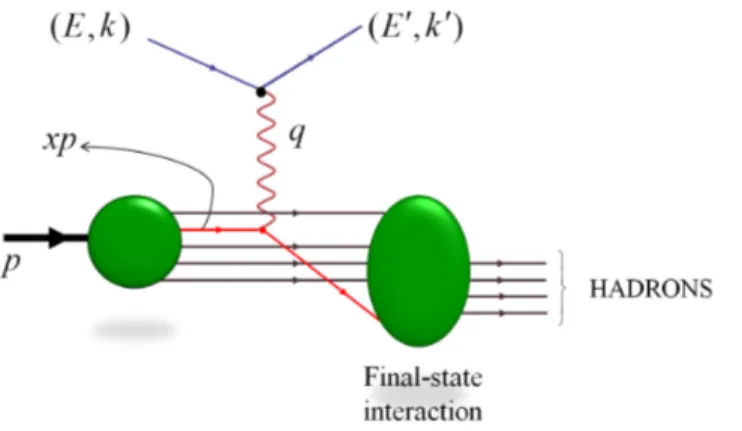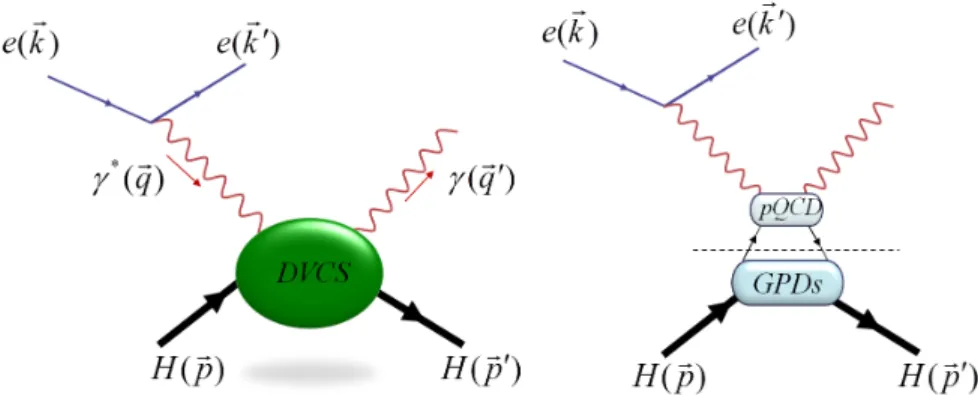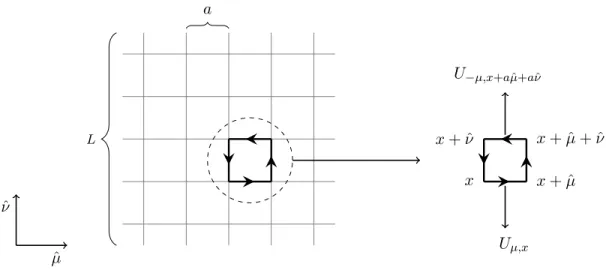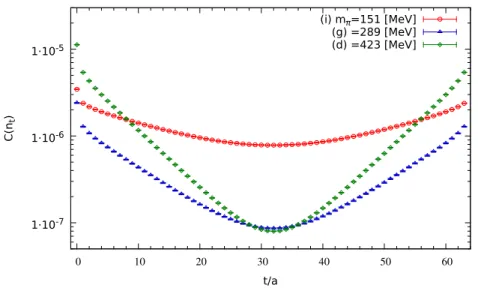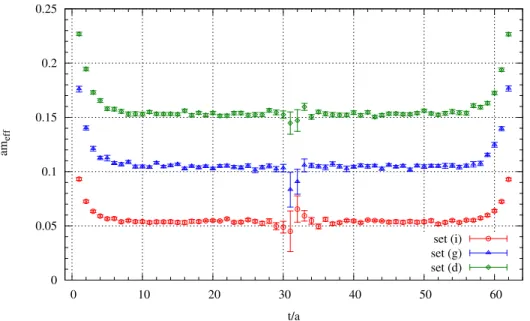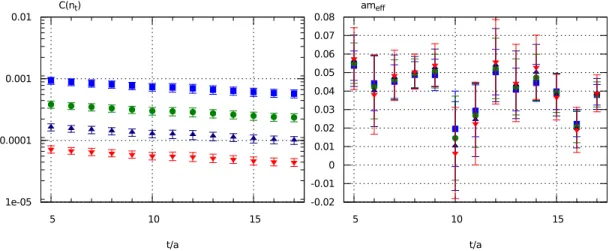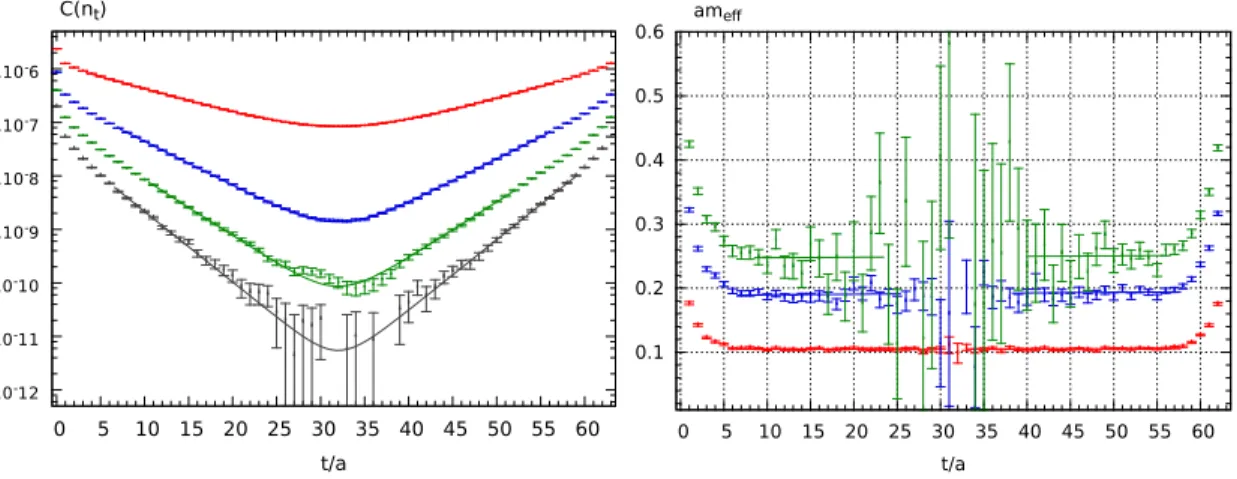Pion Structure from Lattice QCD
Dissertation
zur Erlangung des Doktorgrades der Naturwissenschaften (Dr. rer. nat.)
der Fakult¨at f¨ur Physisk der Universit¨at Regensburg
vorgelegt von
Narjes Javadi Motaghi
aus Arak, Iran
im Jahr 2015
pr¨ufungsausschuss: Vorsitzender: Prof. Dr. C. Strunk 1. Gutachter: Prof. Dr. G. Bali 2. Gutachter: Prof. Dr. V. Braun weitere Pr¨ufer: Prof. Dr. F. Evers Termin Promotionskolloquium: 12.05.2015
I dedicate this thesis to my beloved parents
Contents
1 Preface 1
2 Phenomena 7
2.1 Deep Inelastic Scattering (DIS) . . . 7
2.1.1 Kinematics . . . 8
2.1.2 Parton Model . . . 9
2.1.3 DIS Cross Section . . . 9
2.2 Deeply Virtual Compton Scattering . . . 12
2.2.1 Definition and Properties of GPDs . . . 12
2.3 Moments of GPDs . . . 15
2.4 Generalized Form Factors . . . 16
2.5 Pion Electromagnetic Form factor . . . 18
2.5.1 The pion Charge Radius . . . 18
3 Quantum Chromodynamics on the Lattice 21 3.1 QCD in the Continuum . . . 21
3.1.1 The Fermion Action . . . 22
3.1.2 The Gauge Field Action . . . 23
3.2 QCD on the Lattice . . . 24
3.2.1 Discretization and Formulation of Lattice Action . . . 24
3.2.2 Lattice Fermion Action . . . 25
3.2.2.1 Gauge Fields on the Lattice . . . 26
3.2.2.2 Lattice Gauge Action . . . 28
3.2.2.3 Fermions on the Lattice . . . 29
3.2.2.4 Wilson Fermions . . . 31
3.2.2.5 Clover–Wilson Fermion . . . 31
3.3 Path Integral . . . 32
3.4 Monte Carlo. . . 33
3.5 Lattice scaling . . . 33
4 Matrix-elements 35 4.1 Euclidean Correlator . . . 35
4.1.1 Construction of Meson Interpolators . . . 37
4.1.2 Construction of Two-Point Function . . . 39
4.2 Source and Sink Smearing . . . 40
4.2.1 Point Source . . . 40
4.2.2.2 Link Smearing . . . 42
4.3 Three-Point Functions . . . 43
4.3.1 Construction of Three-point Function . . . 45
4.3.1.1 Connected Contributions . . . 46
4.3.1.2 Sequential Source Technique . . . 47
4.4 Lattice Operators . . . 48
4.4.1 Renormalization of Operators . . . 49
5 Results for Two-point function 53 5.1 Two-Point Functions . . . 53
5.1.1 The Calculation of Excited State Energy . . . 54
5.1.2 Effective Mass . . . 55
5.1.3 Smearing . . . 57
5.1.4 Finite Momenta . . . 59
5.1.5 Finite Size Effect . . . 59
6 Pion Parton Distribution Function 63 6.1 Lattice calculations . . . 63
6.2 Details of the Simulations . . . 64
6.2.1 Excited State Contamination . . . 70
6.3 Forward Limit of GPDs . . . 72
6.3.1 Moments of PDF (Experiments and Modeling) . . . 74
6.3.2 Moments of PDFs (Lattice Results) . . . 75
6.3.3 Finite Size Effect on moments of PDF . . . 75
6.4 Results of PDFs . . . 76
7 Pion Form Factors and Generalized Form Factors 81 7.1 Form Factor - Experiments and Lattice . . . 81
7.2 Results for Electromagnetic Form Factor. . . 83
7.3 Generalized Form Factor . . . 87
8 Summary 91 A Notations and conventions 95 A.1 Parity Transformation . . . 95
A.2 Charge Conjugation . . . 95
A.3 Conventions in Gamma Matrices . . . 96
B Conventions for Our Calculations 97 B.1 Operators . . . 98
B.2 Pion Electromagnetic Form Factors . . . 98
B.3 Pion Tensor Form Factors . . . 99
B.4 Moments of GPDs . . . 99
C Jackknife Error Estimates 101
“Physics is a form of insight and as such it’s a form of art.”
— David Bohm
Chapter 1
Preface
The history of elementary particle physics is around 100 years old. Elementary par- ticle physics was born in 1897 with the discovery of the first elementary particle, the electron, by J.J.Thomson1. The electron was and still is considered as an elementary particle which means a point-like particle with no inner structure. In contrast to the electron, atoms have an inner structure which was first shown by Rutherford’s gold foil experiment in 1911 [Rut11]. It showed that each atom consists of a nucleus which contains most of the atom’s mass and it is surrounded by a cloud of electrons.
Until 1918 the proton was the only other known elementary particle. Later, in the early 30s another particle named neutron was discovered which was slightly heavier than the proton but carried no charge. The nature of the force which keeps the nucleus together was yet missing. Though, it was clear it must be a very strong force, only attractive for protons and neutrons with very short range, and therefore not noticeable in everyday life.
In 1935 a new field was predicted by Hideki Yukawa. He proposed the existence of an exchange particle for the strong force which should have the mass of nearly 300 times that of the electron, but about a sixth lighter than the proton. He called it meson (middle–weight) which should be responsible for the exchange of the strong force between protons and neutrons. However, no such particle had been observed in the laboratory before.
At that time a number of cosmic rays studies were in progress, and in 1937 two different groups identified a particle matching Yukawa’s description. But the observed cosmic ray particle had a wrong lifetime and interacted very weakly with the atomic nucleus. Moreover, it was significantly lighter than expected from Yukawa’s predic- tion. This puzzle was resolved in 1947 by physicists at Bristol University in England.
They discovered the existence of two middle–weight particles in cosmic rays, which are known today as thepion π and muon µ. The pion was identified as the true Yukawa meson. Simultaneously, the same conclusion on theoretical grounds was reached by Marshak [MB47]. Pions are produced in huge numbers when cosmic rays bombard the earth and collide with atoms in the upper atmosphere. These pions ordinarily decay long before reaching the ground and the Bristol group therefore had to display their photographic emulsions on mountain tops. Later, particle physics experiments showed
1We follow the lecture notes of [Fra02] and chapters 1 and 2 [Gri08] and references therein.
theµ does not participate in the strong nuclear interaction and nowadays it classified as a lepton and not a meson.
The existence of pions as charged particles was identified by their double traces on photographic plates. Charged pions decay to a muon and a neutrino (or anti-neutrino)
π−→µ−+ ¯νµ, (1.0.1)
π+→µ++νµ. (1.0.2)
The branching ratio2 says that the probability for the decayπ+(−)→µ+(−)+νµ(¯νµ) is larger than that forπ+(−)→e+(−)+νe(¯νe). Besides the charged pions, there is also a chargeless one, theπ0, which does not leave traces in photographic plates. The neutral meson was therefore discovered later in 1950. Aπ0 decays as
π0→e−+e++γ. (1.0.3)
The neutral pion has lifetime of about 10−16 seconds, whereas the charged ones have longer lifetimes of about 2.6×10−8s. A π0 is π0 = 1/√
2|u¯u−ddi¯ and the charged pions are made of a pair of quark anti-quark, each (π− = |d¯ui, π+ = |udi). The¯ neutral pion is slightly lighter than charged pions, mπ± = 139.57 MeV and mπ0 = 134.97 MeV [B+12, O+14]. The deviation between masses can be due to the electro- magnetic self-energy [D+67]. The strong interaction properties of the three pions are identical.
The Nobel Prizes in Physics were awarded to Yukawa in 1949 for his theoretical prediction of the existence of pions, and to Cecil Powell in 1950 for developing and applying the technique of particle detection using photographic emulsions.
Besides pions and muons, many other particles have been discovered in the 40’s and 50’s by operating the new high energy accelerators, as Willis Lamb humorously pointed out in his Nobel prize acceptance speech: “When the Nobel prizes were first awarded in 1901, physicists knew something of just two objects which are now called elementary particles: the electron and the proton. A deluge of other elementary particles appeared after 1930; neutron, neutrino,µmeson,π meson, heavier mesons and various hyperons. I have heard it said that the finder of a new elementary particle used to be rewarded by a Nobel Prize, but such a discovery now ought to be punished by a$10,000 fine [Gri08, pn55]”. The particle zoo began to fill including elementary particles and also composite ones, like hadrons. However, at that time it was yet unclear which one was elementary and which was not.
A first successful attempt to introduce some structure into the particle zoo was done by Gell-Mann and independently by Zweig in 1964 [GM64, Zwe64]. They introduced that hadrons consist of elementary constituents called quarks. In the original quark model, quarks came in three flavors up, down and strange, but later until 1983 other three quarks charm, top and bottom were discovered [Ros81]. Quarks are elementary
2There are severals ways for a particle to decay. The probability of its decay to a particular mode is known as its branching ratio for that decay mode.
particles with spin 1/2 and fractional electric charge flavor charge u c t +23e d s b −13e
(1.0.4)
Initially, there had been many doubts on the real existence of quarks as the inner constituents of hadrons. But this was eventually proven by some experiments like deep inelastic scattering (DIS) experiments at the Stanford Linear Accelerator Center (SLAC) in 1968 [B+69].
The quark model was successful in classifying hadrons as bound states of quarks but at the same time another problem appeared: the existence of a hadron consisting of three up quarks with parallel spin ∆++ [Bru52]. It showed that quarks have to have a further quantum number, otherwise these states would violate Pauli’s exclusion principle. It says that no two particles with half integer spin can occupy the same state.
The puzzle was solved by O. W. Greenberg [Gre64]. He proposed that quarks come not only in three flavors but each of them also comes in three color charges commonly named red,green and blue. These color charges have nothing to do with visible colors of light in everyday life. All observed hadrons are colorless.
Nowadays we look at the strong interactions from the point of view of a quantum field theory. The theory describing the strong interactions between the quarks is called Quantum Chromodynamics3 (QCD). It is a non-Abelian gauge theory with the gauge group SU(3) which comes with eight massless vector bosons, called gluons. These gluons are the exchange particles in the strong interaction between quarks and gluons.
Since it also features a self-interactions between gluons, it has the very important property of asymptotic freedom.
Asymptotic freedom for non-abelian gauge theories was discovered in 1973 by Wilczek and Gross [GW73b] and independently by Politzer [Pol73], all receiving the Nobel Prize in 2004. For QCD, it implies that at high energies or equivalently short distances, the strong force between quarks becomes zero. This means the coupling constant4 αs, tends to be zero and the particles behave as free particles. It indicates that within the hadron, quarks can move without much interacting. Due to this, at high energy region, perturbative treatment of QCD allows us to describe hadronic phenomena.
Conversely, at low energy, the coupling constant increases and it becomes impossible to detach individual quarks and gluons (called partons) from hadrons. This phenomena is called confinement [C+79]. Therefore, at low energy, a perturbative treatment of QCD in an expansion of the coupling constant is not possible. In this regime, hadronic models and effective theories come into play.
One approach to perform non-perturbative QCD calculations is given throughlattice QCD. The main idea of lattice QCD is to formulate continuum QCD in discretized Euclidean space-time. Lattice QCD can be treated numerically by means of Monte Carlo simulation to estimate path integrals. It is explained in chapter3.
3Since QCD is the theory of color charge, the Greek word “chroma” is applied to its name [Fey85].
4The strong coupling constant is a dimensionless number that tells us how strong an interaction is.
Analysis of the coupling constant in QCD gives the first order expression ofαs(E) = (33−n 12π
f) ln[E2/Λ2]
withnf as the number of quark flavors and Λ is a free parameter determined experimentally.
An essential tool to investigate the inner structure of hadrons is the study of (gen- eralized) parton distributions in hadron. In this regard, one can look inside the hadron with good resolution. These probes can be performed by hard experiments like deep inelastic scattering (DIS), semi-inclusive deep inelastic scattering (SIDIS) and deeply virtual Compton scattering (DVCS).
The knowledge of PDFs mostly comes from deep inelastic scattering experiments.
By virtue of the factorization theorem5, the scattering cross section of such a process factorizes into a hard and a soft part.
Th hard part describes the process at short distances (high energy transfer). In this region, the interaction between quarks and gluons are weak, and so this part can be described via perturbation theory. The soft part, in contrast, encodes all information about interaction between quarks and gluons at large distances (low energies) and can not be treated perturbatively. It is the part that is parametrized by hadron structure functions, as for example the PDFs. These structure functions contain all the non- perturbative information about the internal structure of hadron. Along this thesis we are interested in non-perturbative part of process.
In this work, we study moments of parton distribution functions (PDFs) on the lattice. We also look at moments of generalized parton distribution (GPD) [Rad96, Rad97,Ji97,Ji98]. They encode the inner structure of hadrons in terms of the incom- ing and outgoing quark in the non-perturbative region which are accessible via deeply virtual Compton Scattering (DVCS). GPDs include PDFs and electromagnetic form factor (FF) which can be extracted from electron-proton elastic scattering experiments.
Experimentally, measuring GPDs is a big challenge requiring high resolution. Hence, only the very first dedicated experiments have been planned and performed, (e.g. HER- MES collaborations [A+01], H1 collaborations [A+05], ZEUS collaborations [C+03] and CLAS collaborations [S+01]). For these, theoretical input for moments of theses PDFs or GPDs are highly welcome.
Outline of this Work
Our goal is to provide theoretical input for pion structure functions from first princi- ples. Pions are the lightest hadrons in the quark model, consisting of a pair of quark and an anti-quark. In chapter2 we give a brief introduction to DIS and DVCS experi- ments and present some aspects of parton distribution functions and generalized parton distribution functions. We also mention how to calculate the pion charge radius from electromagnetic form factors. The lattice formulation of QCD is summarized in chapter 3. The tools to calculate observables in lattice QCD using Monte Carlo techniques are explained as well.
In chapter4we explain how the expectation values of our observables are computed.
These primarily are given through hadronic two- and three-point functions which for the later we use the sequential source techniques. In the final section, we introduce a our regularization scheme which we use to renormalize and convert lattice results into physical numbers.
Chapter 5 is the starting point for our discussion of results for the pion two-point
5For a nice explanation look at [Lau14] and [Cou10].
functions. We discuss how to extract the ground state energy and also analyze ex- cited state contributions. In chapter6 we discuss our data for the second moment of the pion parton distribution functions, in particular, close to the physical quark mass.
These have been obtained by performing high-performance computations on Super- computers. We also evaluate contaminations in our data due to excited states for one ensemble with different values for sink position,tsink. In chapter7, we analyze the pion electromagnetic form factor and the generalized form factors.
We summarize and conclude in chapter8 and give points for future studies.
Chapter 2
Phenomena
Between 1967 and 1973 a series of electron-hadron scattering experiments were per- formed at the Stanford Linear Accelerator Center (SLAC). The findings of those ex- periments showed that at high energy transfer the hadron is not a fundamental particle but a bound state of point-like constituents, called partons [Fey88]. The distribution of momentum is encoded in the so-called parton distribution functions which can be pro- duced by hard scattering processes like deep inelastic scattering (DIS), deeply virtual Compton scattering (DVCS), and Drell-Yann photo production.
We start this chapter by looking at the kinematics of DIS and DVCS experiments and give a brief introduction to hadron structure functions1.
2.1 Deep Inelastic Scattering (DIS)
There exists different experiments for the study of hadron structure. These experiments are named with respect to their main focuses. When in a process an initial lepton with very short wavelength probes distances much shorter than the size of the target hadron, it is calleddeepprocess. When in a scattering process the incident and resultant particles are the same, like Compton scattering (right diagram of Fig.2.1.1), the process is called elastic scattering. While, when the target absorbs some energy and breaks up to many final particles, it is calledinelastic scattering (left diagram Fig. 2.1.1). So in deep inelastic scattering experiments, a high energy lepton interacts with the target hadron and breaks it to different other final states.
Moreover, if in a scattering process, more than a couple of final states are produced, different instruments are needed to detect the resultant particles. If only the scattered lepton is detected and the rest left unmeasured, it is called inclusive DIS. Whereas, when in addition to the scattered lepton, one or two high energy hadrons are detected, it is calledsemi-inclusive one. In the case that all final state particles and their momenta are known, it is called exclusive scattering. In the following, we discuss the exclusive DIS experiment and explain how these are used to obtain information about hadron structure functions therefrom.
1We follow [BR05] and [BP07], chapters 6 and 8 in [HM84], 2 and 3 in [Bas07], section 2 in [Sch98].
Figure 2.1.1: Left: Basic diagram for deep inelastic lepton-hadron scattering mediated by virtual photon exchange. Right: Elastic scattering, the hadron has exchanged its momentum, unlike the DIS process where hadron has been smashed into other particles.
2.1.1 Kinematics
DIS allows us to investigate the internal structure of hadrons. Most of our knowledge about hadron structures has been derived from lepton-hadron scattering
l(k) +H(p)→l0(k0) +X(px). (2.1.1) Here,l labels the initial lepton with 4-momentumk and energyE andl0 the outgoing lepton with 4-momentumk0 and scattered energyE0. X denotes all the final hadronic states with massMX. The kinematic variables describing the DIS process are
• Q2 =−q2= (k−k0)2 = 4EE0sin2(θ2): The squared 4-momentum transfer of the virtual photon.
• θ: Lepton scattering angle.
• ν = E−E0 = p·q/MH: The energy loss of the lepton which can be associated with the energy of the virtual photonγ∗.
• MH: The mass of target hadron.
• p= (M, ~0): The 4-momentum of the fixed target.
• q= (E−E0, ~k−~k0): The 4-momentum of the virtual photon.
• y=ν/E: The fractional energy loss of the lepton.
• xB = 2MQ2
Hν = 2p·qQ2 : The Bjorken scaling variable.
By increasingQ2, the spatial resolution increases and the quark structure of the hadron can be seen.
2.1 Deep Inelastic Scattering (DIS) 2.1.2 Parton Model
DIS experiment is the key to evaluate parton densities,q(x), and Helicity distributions,
∆q(x), of hadrons [BP07]. A parton density is the probability of finding a parton with longitudinal momentum fraction x of its parent hadron, regardless of its spin directions. Helicity is the layout of a parton spin parallel or anti-parallel to the direction of the parent momentum. With respect to the positive helicity for parent, the number density of partons with positive helicity minus the negative ones is known as helicity distributions.
The basic idea of the parton model is that at high energy, an initial lepton interacts with one of the partons in the hadron by exchanging a virtual photon. It is shown schematically in Fig. 2.1.2. The structureless feature of partons is symbolized by the point notation in the Figure. To the lowest order, the interacting parton is a quark, since the gluon has no electric charge. All information about the target hadron in inclusive scattering processes are collected in the structure functions. We will see that to leading order at high energy momentum transferQ2→ ∞, the hadron structure functions are independent of the dimensional parameterQ2 but depend on the fixed scaling variable xB proposed by Bjorken [BP69], which can be obtained from the invariant mass of the hadronic states
MX2 = (p+q)2=M2+ 2p·q+q2. (2.1.2) Here, MX at least must be the same as the mass of the hadron MX2 ≥ M2. By implementingq2=−Q2 in Eq. (2.1.2) we obtain
M2+ 2p·q−Q2≥M2 ⇒ xB= Q2
2p·q ≤1. (2.1.3) It means that the longitudinal momentum fraction x is equal to the Bjorken scaling variablexB. Since Q2 and p·q are both positive, it follows that
0≤xB ≤1 (2.1.4)
where xB = 1 corresponds to elastic scattering (MX2 = M2). Also the lepton energy lossE−E0 is between zero (if E=E0) andE (ifE0 = 0), so the fractional energy loss of the lepton must be in the interval
0≤y≤1. (2.1.5)
2.1.3 DIS Cross Section
Studying the total cross section of a process is the first step towards an understanding the structure of hadrons [Jaf75]. The meaning of a cross section can be illustrated as follows; if an arrow is fired towards a ball, by increasing the radius of the ball the chance of hitting would go up and the cross section area will increase. However, in particle physics it is more complicated than in archery. In an experiment, the target is not a solid ball but a soft one. Moreover, because of different involved interactions,
Figure 2.1.2: Kinematics of lepton-hadron scattering in the parton model. The photon interacts with a single quark of the hadron.
the cross section depends on the nature of the fired arrow and the target both. Also, the incident particle can be scattered to different angles. The probability of interaction with particular scattered angle is measured by the differential cross section2.
The differential cross section for the unpolarized DIS in the laboratory frame can be written as
dσ=X
X
Z d3k0
(2π)32E0(2π)4δ4(k+p−k0−Xp) |M|2
2E2M. (2.1.6) Here, Mis the scattering amplitude containing all information about the interaction.
The polarization of the final lepton and hadrons have to be summed over. According to the factorization theorem, the spin-averaged M factorizes into the leptonic tensor also called hard part,Lµν, and the hadronic tensor called soft part,Wµν, as
|M|2 ∼LµνWµν (2.1.7)
where Lµν and Wµν can be calculated perturbatively and non-perturbatively, respec- tively. The advantage of studying lepton-hadron scattering but not hadron-hadron scattering is that the lepton is a point-like particle. Therefore, the exact expression for Lµν can be written
Lµν = X final states
hk0|Jlν(0)|k, slihk, sl|Jlµ(0)|k0i (2.1.8) whereJl is the leptonic current.
The hadronic tensor Wµν (shown in Fig.2.1.3) contains all information about the hadrons involved in the process. Its calculation is much more complicated. Hadronic tensor can be expressed as the imaginary part of the forward scattering amplitude in deeply virtual Compton scattering
Wµν = 1
2πImTµν (2.1.9)
2We mostly follow [Gri08,Sch98,Man92] and references therein.
2.1 Deep Inelastic Scattering (DIS)
Figure 2.1.3: Hadronic tensor of deep inelastic scattering cross section. It detects the imaginary part of the forward Compton scatteringγ∗(q)H(p)→γ∗(q)H(p) [BR05].
where
Tµν =i Z
d4z eiq·zhp, λ0|T {Jµ(z)Jν(0)}|p, λi. (2.1.10) Here,T {Jµ(z)Jν(0)}is the time-ordered product of the currentsJµ(z) andJν(0). This relation is known as the optical theorem. So
Wµν =X
λ,λ0
1 4π
Z
d4z eiq·zhp, λ0|Jµ(z), Jν(0)|p, λi (2.1.11) whereλ(λ0) is the polarization of the initial (final) hadrons. Fig.2.1.4 illustrates this relation.
The hadronic tensorWµν can be written in terms of a spin dependent part which is anti-symmetric and a spin independent one which is symmetric. The polarized lepton and polarized target produce the anti-symmetric leptonic tensor and anti-symmetric hadronic one. The product of these anti-symmetric leptonic and hadronic tensors re- sults in the polarized form factors. In contrast, in unpolarized scattering, one averages over the target polarization and the spin dependent part ofWµν vanishes. Therefore, using an unpolarized lepton beam and an unpolarized hadron target is sufficient to measure unpolarized form factors [Bas07].
The spin independent part ofWµν decompose into two unpolarized structure func- tions,F1 and F2, which depend on two Lorentz invariant quantities
Wµν =−F1(xB, Q2)
gµν−qµqν q2
+ F2(xB, Q2) p·q
pµ−p.q q2 qµ
pν− p.q q2 qν
. (2.1.12) Here,Q2=−(pl−pl0)2 <0 is the squared four-momentum transfer by virtual photon.
It is known as the scale (resolution) to probe the inner structure of the hadron.
In the Bjorken limit, Q2 → ∞, structure functions depend only on xB. These Bjorken scaling functions are related to each other by the Callan-Gross relation [CG69]
F1(x) = 1
2xF2(x) (2.1.13)
with
F2(x) =X
q
e2qx qq(x) (2.1.14)
Figure 2.1.4: The optical theorem: the total cross section of the DIS is equal to the imaginary part of the forward Compton scattering. Inspiration for this figure is from [G+13].
where eq denotes the electric charge of the struck parton. q(xB) is the probability of finding a parton q with a longitudinal momentum x
q(x) = (q↑+q↓)(x) + (¯q↑+ ¯q↓)(x) (2.1.15) which is called parton distribution function (PDF). Eq. (2.1.13) is a result of the fact that fermions which are involved partons in DIS are spin 1/2 particles [Pic95].
2.2 Deeply Virtual Compton Scattering
A modern framework to describe the parton structure in hadrons is given by so-called Generalized Parton Distribution functions (GPDs). Experimentally, GPDs can be mea- sured viaVirtual Compton Scatteringwhich means at least one of the photons involved in the Compton scattering is virtual. VCS amplitude is similar to the hadronic tensor of DIS (see Fig.2.1.3). Since in the Bjorken limit the momentum transfer is large, in this region virtual Compton scattering is also known as deeply virtual Compton scattering which was proposed by Ji [Ji97] and Radyushkin [Rad96]. DVCS is a hard exclusive process in which the lepton interacts with the hadron via a virtual photon under the emission of another photon. The reaction is represented as
l(k) +H(p)→l0(k0) +H(p0) +γ(q0). (2.2.1) DVCS, schematically is illustrated in Fig.2.2.1.
2.2.1 Definition and Properties of GPDs
A current can be constructed from combinations of Γ matrices and Dirac fields, ¯ψΓψ.
Matrix elements of those currents can be expressed in terms of form factors with co- variant normalization hp0|pi = 2p0(2π)3δ(p0 −p), where (pµ) and (p0µ) are the initial and final momentum, respectively3.
DIS and DVCS have similar kinematics. DIS involves forward matrix elements of certain operators (pµ = p0µ) which encode the information about parton distribution
3For this section we follow [Rad96,Rad97,Die03,BR05,Cou10]
2.2 Deeply Virtual Compton Scattering
Figure 2.2.1: Left: schematic diagram of DVCS scattering. At least one of two in- volved photons is virtual. Right: the leading-order handbag diagram. DVCS factorizes into hard parts which is calculable by perturbation theory (pQCD) and the soft parts (GPDs) which can be measured non-perturbatively.
functions (PDFs). DVCS experiments on the other hand include off-forward matrix ele- ments (pµ6=p0µ) and these matrix elements can be parametrized in terms of generalized parton distributions (GPDs).
PDFs are Q2-independent but depend on momentum fraction x. However, GPDs are off-forward, so they are functions ofQ2
Q2 =−t=−∆2 =−(p0−p)2. (2.2.2) Moreover, GPDs require additional variables to describe the initial and final parton states. It is the so-called skewnessξ, which is the longitudinal momentum asymmetry
ξ=−n·∆
2P ·n = p+−p0+
p++p0+. (2.2.3)
Here,nis the light-like four-vector,n±= (1,0,0,±1)/√
2 andp+andp0+are used for the pion momenta in light-cone coordinates which is defined byv±= √1
2(v0±v3) =vn∓4. Schematics of DIS, DVCS and elastic scattering are illustrated in Fig.2.2.2. Regarding ξ, one can split momentum fractionx into the three different regions [Die03]:
• x∈ [−1,−ξ], both partons have negative momenta −(x−ξ) and −(x+ξ), and this corresponds to the emission and absorption of anti-quarks.
• −ξ < x < ξ, one parton has positive momentum while the other one has negative.
It corresponds to the emission of a quark and an anti-quark. In this area GPDs behave like meson distribution amplitudes of finding quark and anti-quark pair.
However, this kind of information is relatively unknown and can not be accessed in DIS.
• x∈[ξ,1], both partons have positive momenta (x−ξ) and (x+ξ), which corre- sponds to the emission of a quark and then absorption of a quark.
4For the comprehensive explanation look at [Col97].
Figure 2.2.2: Left: non-local forward matrix elements hp|ψ¯q(0)Γψq(y)|pi accessed in DIS. Middle: local off-forward matrix elements hp0|ψ¯q(0)Γψq(0)|pi accessed in elastic lepton-hadron scattering. Right: non-local off-forward matrix element hp0|ψ¯q(0)Γψq(y)|pi accessed in DVCS in the region −ξ < x < ξ.
Similarly to DIS experiment, the cross section of a DVCS process can be factorized into a hard part which can be calculated perturbatively and a soft part which is a non- perturbative quantity [JO98]. This decomposition is often called a handbag diagram illustrated in Fig. 2.2.1.
GPDs, representing the soft part of the scattering, are defined through a Fourier transform of matrix elements of quark and gluon operators at a light-like separation.
The gluon operators will not be considered in our work. The bilocal quark operators are defined as [Hag10]
OqΓ(x) = Z +∞
−∞
dz
2πeixz·nq(−z
2 ·n) ΓW[−z
2·n,z2·n]q(z
2·n) (2.2.4) wherexis the momentum fraction of the quark and Γ has the Dirac structures Γ =γµ, γµγ5,iσµν to construct the axial, vector and tensor operators. W is a Wilson line along a light-like path between two quarks to guaranty the gauge invariance of the matrix elements
W =Pexp
ig Z −z
2
z 2
dx n·A(xn)
. (2.2.5)
Here,P represent a path ordered integral andn·Aindicates the light-cone gauge. The pion GPDs for vector and tensor operators are then described by [Die03]
hπ(~p0)|OµV(x)|π(~p)i= 2¯pµHπ(x, ξ, t) + higher twist, (2.2.6) hπ(~p0)|OµνT (x)|π(~p)i= p¯[µ∆ν]
mπ
ETπ(x, ξ, t) + higher twist (2.2.7) with definition ofA[µBν] =AµBν −AνBµ. Hπ(x, ξ, t) and ETπ(x, ξ, t) are unpolarized form factors since it is averaged over the quark helicities.
Forward Limit
The matrix elements in Eq. (2.2.6) and (2.2.7) are off-forward because the momenta of the initial and final hadrons are different. In the forward limit, p = p0, hence
2.3 Moments of GPDs
∆ =p−p0 = 0 andξ= 0. It means the fraction of the longitudinal momentum carried by the struck parton is the Bjorken variable x → xB. As a result, the generalized parton distributions in the forward limit are reduced to ordinary parton distributions calculated in DIS [BP07]
Hπ(xB,0,0) =
q(xB), xB>0
−¯q(−xB), xB<0. (2.2.8) Parton distribution functions (PDFs) are the probability to find a parton with momen- tum fraction 0≤x≤1.
2.3 Moments of GPDs
Eq. (2.1.10) indicated that by means of the optical theorem, deep inelastic structure functions can be determined by the commutator of two non-local currentsJµ(z)Jν(0), sandwiched between hadronic states. At short distances, around the light-conez2 →0, the currents product can be expanded into a series of local operators [WZ72]
lim
z2→0Oi(z)Oj(0) =X
k
cijk(z)Ok(0) (2.3.1) wherecijk called Wilson coefficients which depend on the separation z. This is called an operator product expansion (OPE). Hence, to compute the matrix elements, the operator product can be replaced by the expansion (2.3.1) where the Wilson coefficients are independent of the matrix elements [GW73a]. The same OPE holds for virtual Compton structure functions as well [MV00].
The matrix elements of operators in the hadronic tensor correspond to the Mellin moments of the structure function. The Mellinn–th moment of a functionf is defined as [C+72]
Mn= Z 1
0
dx xn−1f(x), n= 1,2, . . . . (2.3.2) The inverse of all Mellin moments would give us the function f.
Twist-two Operators
By means of the OPE, instead of the light-cone operators, tower of local operators Oµn1···µn which are traceless and symmetric inµiare used. In DIS kinematics, 0< xB=
Q2
2MHν <1 and an operator with dimensiondand spinnis of orderO(x−nB )(MH/Q2)d−n−2. It means an operator being controlled by exponent ofd−n−2, whered−nis [GT71]
twist = dimension (d)−spin (n). (2.3.3) The minimal twist (= 2) has the main contributions which corresponds to maximal spin. A finite amount of twist-two operators are contributing to the structure functions in the deep inelastic limit. The twist-two operators are written in terms of quark fields ψ, gluon fieldsFµν and covariant derivativesDµ. Their spin, dimension and twists are
ψ Fµν Dµ
d 32 2 1
n 12 1 1
t 1 1 0
Table 2.3.1: Dimension and twist.
listed in Table2.3.1. Note that adding derivatives to the operator will not change the twist, because spin and dimension both increase by one and according to Eq. (2.3.3), their contributions in changing twist is zero. The twist-two operators for quark and gluon have different forms. The gluonic operators are not discussed here and the general forms of traceless twist-two operators for quarks are written as (see, e.g., [Sch98])
OM q{µ1···µn} =in−1ψ¯(f)γ{µ1←→
Dµ2· · ·←→
Dµn}ψ(f0), (2.3.4) OM σq[µ1{ν]···µn} =in−1ψ¯(f)iσ[µ1{ν]←→
Dµ2· · ·←→
Dµn}ψ(f0) (2.3.5) whereψ(f) denotes a quark field with flavorf,←→
Dµ= 12(−→ Dµ−←−
Dµ) is the symmetrized covariant derivative,σµν =i/2[γµ, γν]. The notation{µ1µ2}indicates the symmetriza- tion inµ1 andµ2 and [µ1ν] anti-symmetrization inµ1 andν. We should note that one at first has to symmetrize and then anti-symmetrize the indices, i.e. for example
O[µ1{ν]µ2} =1
2(O{µ1ν}µ2 +O{µ1µ2}ν)
=1
4(Oµ1νµ2− Oνµ1µ2+Oµ1µ2ν− Oµ2µ1ν). (2.3.6)
2.4 Generalized Form Factors
The off-forward pion matrix elements of a local vector operator for the first moment (n= 1) reads
hπ(~p0)|ψ¯q(0)γµψq(0)|π(~p)i= 2¯pµAπ1,0(t). (2.4.1) Here,Aπ1,0(t) corresponds to the single pion form factorfππ(t), which counts the number of valence quarks of one flavor inside the pion. Similarly, the off-forward pion matrix element of a local tensor operator forn= 1 is parametrized by
hπ(~p0)|ψ¯q(0)iσµνψq(0)|π(~p)i= p¯[µ∆ν]
mπ
BπT1,0(t) (2.4.2) whereBTπ1,0 denotes the pion tensor form factors. BothAπ1,0(t) and BTπ1,0(t) are func- tions of momentum transfertand independent ofξ[Die03]. Comparing Eq. (2.4.1) and (2.4.2) with (2.2.6) and (2.2.7) respectively gives the following sum rules [Ji97]
Z +1
−1
dx Hπ(x, ξ, t) =Aπ1,0(t), (2.4.3) Z +1
−1
dx ETπ(x, ξ, t) =BTπ1,0(t). (2.4.4)
2.4 Generalized Form Factors
Figure 2.4.1: Sum rules to link the first moment of the GPDs to their GFFs.
Here, the negative x region −1 < x < 0 corresponds to an anti-quark distributions.
These sum rules are illustrated in Fig. 2.4.1. In order to get the full form factor, we have to sum over all flavors.
The second moment (n= 2) of the off-forward pion matrix elements of twist-two vector and tensor operators can be parametrized by generalized form factors (GFFs)
hπ(~p0)|OVµν(0)|π(~p)i= 2¯pµp¯νAπ2,0(t) + 2∆µ∆νC2,0π (t), (2.4.5) hπ(~p0)|OµνρT (0)|π(~p)i=AµνSνρp¯µ∆ν
mπ
¯
pρBTπ2,0(t) (2.4.6) where Aπ2,0, C2,0π and BTπ2,0 represent the pion generalized form factors and A and S are functions to anti-smmetrize and symmetrize the indices which were explained in Eq. (2.3.6). The second moments of the pion GPDs are equivalent to GFFs by using Mellin transformation
Z +1
−1
dx x Hπ(x, ξ, t) =Aπ2,0(t) + (−2ξ)2C2,0π (t), (2.4.7) Z +1
−1
dx x ETπ(x, ξ, t) =BTπ2,0(t). (2.4.8) In the forward limit (∆→0, ξ →0), Aπ2,0(0) simplifies to
hxiπ = Z 1
−1
dx x qπ(x) =Aπ2,0(t= 0) (2.4.9) which is interpreted as the momentum fraction carried by partons in the pion.
Now we can write the general form of the matrix elements of the tower of twist-two operators between unequal momentum states. All possible form factors for the vector quark operators arise [Ji98]
hπ(~p0)|O{µq 1···µn}|π(p)i= (2.4.10) 2¯p{µ1p¯µ2· · ·p¯µn}An,0(t) + 2
n
X
i=0 odd
∆{µ1∆µ2· · ·∆µiPµi+1· · ·Pµn}Cn,i(t)
and for tensor operators
hπ(~p0)|O[µσq1{ν]µ2···µn}|π(p)i= 1 mπ
n
X
eveni=0
¯
p[µ1∆{ν]∆µ2· · ·∆µip¯µi+1· · ·p¯µn}BT n,i(t).
(2.4.11) Note that for the tensor operator, one has to first symmetrize and then anti-symmetrize [G+99a]. The higher moments of GPDs for twist-two operators are related with GFFs as
Z +1
−1
dx xn−1Hπ(x, ξ, t) =Aπn,0(t) +
n
X
i=1odd
(−2ξ)i+1Cn,i+1π (t), (2.4.12) Z +1
−1
dx xn−1Eπ(x, ξ, t) =BT n,0π (t). (2.4.13) In case that ξ= 0, the information from PDFs and form factors are combined and GPD(x,0, t) can be explained as the probability of finding a quark with longitudinal momentum fractionx at a given transverse distance in the hadron [G+13].
2.5 Pion Electromagnetic Form factor
In elastic processes, soft physics at the long distance are parametrized in terms of form factors. A form factor is a function that gives the information about a certain particles interaction. It is measured experimentally by
dσ
dΩ = dσ dΩ
point-like |fππ(q2)|2 (2.5.1) wheredΩ is the solid angle and fππ(q2) denotes the form factor at momentum transfer q =k0 −k. Since the pion is a spinless particle, the Lorentz decomposition of matrix elements for current Jemµ provides only one electromagnetic form factor (Eq. (2.4.1))
hπ(~p0)|Jemµ (~p0−~p)|π(~p)i= 2¯pµfππ(t) with t≡∆2 = (p0−p)2 (2.5.2) where p and p0 are the incoming and outgoing momenta, t is the momentum transfer and ¯pµ = (p0+p)/2. The form factor fππ describes the charge distribution of a pion, that is the deviation of a pion from being a point-like charge interacting with the electromagnetic field. There have been early measurements of the pion form factors (see, e.g., [B+78,A+86,B+83,H+08b,H+06]).
2.5.1 The pion Charge Radius
We are interested in the cross section for scattering leptons from a point charge to deduce the structure of the target from the form factor. The form factor for a static target can be written as the Fourier transform of the charge distribution [Hof56]
fππ(q2) = Z
ρ(r0)e−iq·r0d3r0 (2.5.3)
2.5 Pion Electromagnetic Form factor
Figure 2.5.1: Spherical coordinates to describe the volume element.
where d3r0is the volume element andρ(r0) is the charge distribution which is normalized as
Z
ρ(r0) d3r0 =1 (2.5.4)
whereρ is assumed to be spherically symmetric. Spherical coordinates can be chosen to describe the volume element as shown in Fig. 2.5.1when q is parallel to z-axis. So, the volume element is driven as d3r0 = r02dr0d(cosθ) dφ. By integrating Eq. (2.5.3) utilized Eq. (2.5.4) one finds
fππ(q2) =
Z Z Z
r02dr0d(cosθ) dφ ρ(r0)e−iqr0cosθ (2.5.5)
= Z 2π
0
dφ Z
r0
Z 1
−1
r02dr0d(cosθ)ρ(r0)e−iqr0cosθ (2.5.6)
= Z
r0
2π[ 1
iqr0e−iqr0cosθ]1−1ρ(r0) r02dr0. (2.5.7) With the definition of the sine function with complex arguments we obtain
fππ(q2) = Z
r0
4πsin(qr0)
qr0 ρ(r0) r02dr0. (2.5.8) If the momentum transfer|q|is not too large, we can Taylor expand sinx =x−x3!3 +
x5
5! +· · · and with Eq. (2.5.4) obtain
fππ(q2) = 1 +1
6q2hr2i+· · · (2.5.9) where hr2i ≡ R
r02ρ(r0) d3r0 ≡ 6|dfdq(q22)|q2=0 known as a charge radius. By using the normalization condition Eq. (2.5.4), we obtain
fππ(0)≡1. (2.5.10)
In the limit |q| → 0, the exchanged photon has the energy much smaller than the energies of the participating particles in a particular scattering process. However, the wavelength is large enough to resolve only the size of the charge distributionρ but it is not sensitive to its detailed structures.
Chapter 3
Quantum Chromodynamics on the Lattice
Quantum chromodynamics (QCD) is the theory of the strong force describing the inter- actions between quarks and gluons. QCD is a quantum field theory with a non-abelian gauge symmetry, given by the groupSU(3).
Strong interactions phenomena cover a large range of energies. Their descriptions within the framework of QCD however, requires different techniques. Perturbation theory is perfectly fitted for the high energy range where QCD behaves asymptotically free. At low and intermediate scales, perturbative QCD is not applicable anymore, but there is lattice QCD which enables us to treat many strong interactions phenomena non-perturbatively.
Before giving a brief summary of lattice QCD, we will look at the continuum for- mulation which will assist us to map the theory onto a four dimensional lattice grid.
In continuum calculations, Minkowski space-time is utilized where a space-time point is given by a 4-vector, sayxµ. It is a combination of the three ordinary dimensions of space withµ= 1,2,3 for three space directions and a single dimension of time, µ= 0.
The explanation of this chapter mainly follows the text books [PS95,Gri08,GL10].
3.1 QCD in the Continuum
The QCD action is defined by the space-time integral over the QCD Lagrange density LQCD
SQCD = Z
d4x LQCD =Sf erm+Sgluon. (3.1.1) It consists of a fermionic1 part, Sf erm which describes the dynamics of quarks (anti- quarks) and their interactions with the gauge fields and a gluonic2 part, Sgluon which encodes the dynamics of the gauge fields and their self interactions.
1A fermion is a half-integral spin particle and obeying the Pauli exclusion principle.
2In particle physics, gluons (or gauge bosons) are the exchange particles for the strong force between quarks.
Quark and anti-quarks are fermions which are represented by a Dirac 4-spinors ψα,af (x),ψ¯α,af (x) (3.1.2) at a given space-time position. Here, α∈[1,2,3,4] stands for Dirac index,a∈[1,2,3]
color index, i.e. green, red, blue and f ∈[1, . . . , Nf] flavor index. Hence every quark flavorψf(x) comes with 12 independent components.
3.1.1 The Fermion Action
The dynamics of the quarks and gluons is given by the Quantum Chromodynamics Lagrangian. In Euclidean space, the Dirac Lagrangian for a non-interacting quark with flavorf and massmf is written as3
LDirac= ¯ψf(x)(γµ∂µ+mf)ψf(x) (3.1.3) where the Euclidean Dirac matricesγµ withµ= 1,2,3,4 are defined in AppendixA.3.
We want to haveLDirac invariant under a symmetry transformation at some space- time points called local gauge transformation as
ψ(x)→ψ0(x) = Λ(x)ψ(x),
ψ(x)¯ →ψ¯0(x) = ¯ψ(x)Λ−1(x) (3.1.4) where Λ∈Ris defined as
Λ(x) =eiθ(x) =eiωa(x)Ta. (3.1.5) Here, ωa(x) ∈ R parametrize the group and they are space-dependent. Ta are gen- erators of the SU(N) group (in QCD, N = 3, they calledGell-Mann matrices which are traceless and Hermitian4 [Geo99]). The normalization of the generators is fixed by imposing tr(TaTb) =δab/2. The property of tr(Ta) = 0 andTa =T†a satisfy the commutator relationship
[Ta, Tb] =i
N2−1
X
c=1
fabcTc (3.1.6)
wherefabc are real numbers calledanti-symmetric structure constants.
But the above Lagrangian, Eq. (3.1.3), is not invariant under this local gauge trans- formation since we pick up an extra term from the derivative of theθ(x) in Eq. (3.1.5).
To guarantee the local gauge invariance of the Lagrangian, every usual derivative is replaced by the covariant derivativeDµ(x) as
Dµ(x) =∂µ+iAµ(x), with ∂µ=∂/∂xµ, Aµ(x) =
8
X
a=1
Aaµ(x)Ta, Aaµ(x)∈R. (3.1.7)
3The Dirac Lagrangian in Minkowski space isLDirac= ¯ψf(x)(iγµ∂µ−mf)ψ.
4Hermitian operator is an operator coincident with its adjoint.
3.1 QCD in the Continuum
Aµ(x) is the four-vector potential. It is necessary to know the transformation for the gauge field in order to preserve the gauge invariance
L[ψ(x),ψ(x), A¯ µ(x)] =L[ψ0(x),ψ¯0(x), A0µ(x)]. (3.1.8) By inserting Eq. (3.1.4) on the right hand side of Eq. (3.1.8) we obtain
L[ψ(x),ψ(x), A¯ µ(x)]= ¯! ψ(x)Λ−1(x) γµ(∂µ+iA0µ(x)) +m
Λ(x)ψ(x). (3.1.9) The mass term cancels out and the rest is
ψ(x)¯ ∂µ+iAµ(x)
ψ(x)=! (3.1.10)
ψ(x)Λ¯ −1(x) ∂µ+iA0µ(x)
Λ(x)ψ(x).
Using the product rule for∂µ in the right hand side produces an additional term ψ(x)¯ ∂µ+iAµ(x)
ψ(x)= ¯!ψ(x)∂µψ(x) + ¯ψ(x)Λ−1(x)(∂µΛ(x))ψ(x) (3.1.11) +iψ(x)Λ¯ −1(x)A0µ(x)Λ(x)ψ(x).
It should be denoted that Λ(x) commutes with theγµ matrices since γµ acts in Dirac space but Λ(x) acts in color space. Considering Λ†(x) = Λ−1(x) and solving forA0µ(x) gives us the transformation law for the gauge fields
Aµ→A0µ(x) = Λ(x)Aµ(x)Λ−1(x) +i(∂µΛ(x))Λ−1(x). (3.1.12) Now we can write the fermionic part of QCD
Sf erm[ψ,ψ, A] =¯
nf
X
f=1
Z
d4xψ¯f(x)(γµDµ+mf)ψf(x). (3.1.13)
3.1.2 The Gauge Field Action
In QCD, gluons mediate the strong interactions of quarks, and they carry color/anti- color charges. They are massless particles, so their Lagrangian contains only the mass term. The field strength tensorFµν(x) is defined as the commutator of the covariant derivatives
Fµν(x) =−i[Dµ(x), Dν(x)] =∂µAν(x)−∂νAµ(x) +i[Aµ(x), Aν(x)]
=
8
X
a=1
h
∂µAaν(x)−∂νAaµ(x)−fabcAbµ(x)Acν(x) i
Ta
=
8
X
a=1
Fµνa (x)Ta. (3.1.14)
Note that in QCD, the commutator [Aµ(x), Aν(x)] does not vanish and in the second line relation (3.1.6) was used. If the field has a local transformation law, its covariant
derivative holds the same law and the commutator of the covariant derivatives as well.
Therefore, it is clear thatFµν(x) under the Eq. (3.1.12) transforms as
Fµν(x)→Fµν0 (x) = Λ(x)FµνΛ−1(x). (3.1.15) Two field strength tensors contract to maintain Lorentz symmetry and take the trace to preserve the gauge symmetry. The gauge action then is given by
SG(x) =− 1 2g2
Z
d4x tr[Fµν(x)Fµν(x)] =− 1 4g2
8
X
a=1
Fµνa (x)Fµνa (x). (3.1.16)
3.2 QCD on the Lattice
Lattice gauge theory was introduced by K. Wilson in 1974 [Wil74]. On a hypercubic grid with spacing a = as = aT, quark fields are placed on sites and gauge fields on the links between sites. So fermion and gluon fields, derivatives, integrals and so on have to be replaced by discretized expressions. For the lattice QCD, we switch from Minkowski to Euclidean space. This allows us to estimate path integrals by means of Monte Carlo integrations. These simulations are used to calculate correlation functions on the lattice. AD-dimensional Minkowski field theory (D−1 spatial dimensions and one time dimension) is connected to a D-dimensional Euclidean field theory by using Wick rotation
x0M ≡t→ −ix4≡ −iτ, xjM ≡xEj (3.2.1)
p0M ≡E →ip4, pjM ≡pEj . (3.2.2)
There are different ways in which the QCD action can be discretized and all must give consistent results in the continuum limit. The purpose of this introduction is to provide an outline about the results that are presented in other sections for correlation functions, effective masses and calculation of matrix elements. For a comprehensive explanation of lattice QCD we found the following books [GL10,TC06, L+11, Fle88]
and reviews of [Gup97,Het12,Gut12] really helpful.
3.2.1 Discretization and Formulation of Lattice Action
First of all we have to introduce the number of nodes in 4-dimensional space-time
x=a
x1
x2 x3 x4
with x1, x2, x3∈ {0,1,· · · , NL−1}, (3.2.3)
x4∈ {0,1,· · · , NT −1}.
Here, points in space-time are separated by lattice constanta,xcont=axlat, and quarks are placed at the lattice points
ψ(x) =ψaxlat. (3.2.4)
